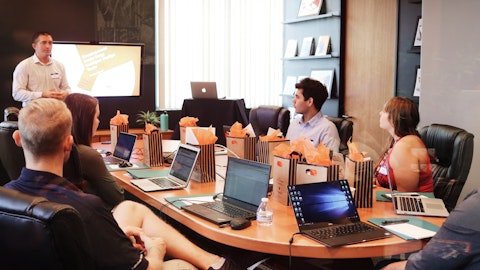USANA Health Sciences, Inc. (NYSE:USNA) Q1 2023 Earnings Call Transcript April 26, 2023
USANA Health Sciences, Inc. beats earnings expectations. Reported EPS is $0.95, expectations were $0.77.
Operator: Good day and welcome to today’s USANA Health Sciences First Quarter Earnings Call. This meeting is being recorded. At this time, I’d like to hand the call over to Andrew Masuda. Please go ahead, sir.
Andrew Masuda: Thank you, and good morning, everyone. We appreciate you joining us to review our first quarter results. Today’s conference call is being broadcast live via webcast and can be accessed directly from our website at ir.usana.com. Shortly following the call, a replay will be available on our website. As a reminder, during the course of this conference call, management will be making forward-looking statements regarding future events or the future financial performance of our company. Those statements involve risks and uncertainties that could cause actual results to differ, perhaps materially from the results projected in such forward-looking statements. Examples of these statements include those regarding our strategies and outlook for fiscal year 2023, as well as uncertainty related to the economic and operating environment around the world, our operations and financial results.
We caution you that these statements should be considered in conjunction with disclosures, including specific risk factors and financial data contained in our most recent filings with the SEC. I’m joined by our CEO and Chairman of the Board, Kevin Guest; our President, Jim Brown; our Chief Financial Officer, Doug Hekking, as well as other executives. Yesterday, after market closed, we announced our first quarter results and posted our management commentary document to the company’s website. We’ll now hear brief remarks from Kevin and Jim before opening the call for questions.
Kevin Guest: Thank you, Andrew, and good morning, everyone. We appreciate you joining us. We’re pleased to report solid first quarter results, which were modestly ahead of our expectations. The team did an excellent job of executing market specific initiatives, which included various in-person events, promotions, and the launch of our new affiliate program in certain markets. As a result, we continued to see stabilization in active customer counts and sequential quarter net sales growth. Accordingly, we have raised the lower end of our net sales and earnings per share guidance for the full year. The global operating environment for our business remains dynamic as ongoing inflationary pressures worldwide continue to meaningfully impact the purchasing decisions of our customers.
Despite these challenges, demand for health and wellness products continues to proliferate, and we remain well positioned to execute our growth strategy. As we mentioned in our previous call, we saw a meaningful increase in demand for our health products in China during the fourth quarter following the government shift in COVID policy. This demand carried over to the first few weeks of the first quarter and added approximately $12 million to net sales. Note that this is a temporary lift in net sales and had a comparable lift in our active customer counts as well. Toward the end of the first quarter, we announced annual price increases in many of our markets, and customer purchasing increased by an estimated $13 million ahead of these increases.
While we have historically seen a trend of increased purchasing ahead of price increases, the amount was higher than anticipated. Separate from these events, our business continue to show signs of further stabilization in the first quarter. As we discussed with you in February, we are making a strategic effort to return to live meetings around the world where possible and are off to a great start. We held several meetings and events in the first quarter, and following the end of the quarter, we held our China National Sales Meeting in Macau. This is our first large scale event in this region in three years, and we are pleased to host nearly 10,000 associates in attendance. The associate engagement we have seen and the feedback that we received from these meetings and events has been excellent.
Gathering and collaborating in-person is critical to our business as it generates excitement, momentum, and renews trust with our salesforce. We have events planned for each of our regions throughout the remainder of the year, and we remain optimistic that these will generate future growth. Notably, we continue to make progress on preparing to open a new market later this year. We plan to announce this new market at our Asia Pacific Convention in South Korea next week. Although this market will not open until later this year, we are optimistic about the long-term growth opportunities it will present, and most importantly, the opportunity it brings to introduce USANA’s world class health products to a new country, culture and demographic. While we can’t discuss the specifics of this market today, we look forward to making this announcement live in South Korea next week.
Stay tuned and watch for a press release with this announcement. Before turning the call over to USANA’s President, Jim Brown, I’d like to comment on our plans for succession in the CEO role. In early February, we announced my plan to transition to the role of Executive Chairman effective July 1. With this transition, Jim will be named CEO of the company, and I speak for myself and the entire board when I say that USANA has full confidence in Jim and his leadership, and ability to curate active customers. It has been my great privilege to be part of USANA for over 30 years and to serve as CEO for the last 8 years and Chairman of the Board since 2020. It’s been extremely satisfying to play a part in advancing USANA’s position as one of the foremost leaders in health and wellness.
I look forward to continually to be deeply involved in USANA’s strategy and mission. In this new role, I want to express that I am not retiring; I’m just shifting strategic roles. I also want to express my sincere appreciation for and confidence in Jim as USANA’s CEO, as well as USANA’s extraordinary management team employees and associates. With that, I’ll turn the time over to Jim, USANA’s future CEO.
Jim Brown: Thank you, Kevin. I, too, want to thank Kevin for his devotion to USANA and for his mentorship. I look forward to working alongside him in his new role as Executive Chairman and I am appreciative of his continued guidance and involvement in our overall strategy and mission. Turning back to the quarter, generating customer engagement and growth is our top priority in 2023, and we’re off to a solid start as we saw stabilization and sequential growth in both active customers and net sales during the first quarter. In the second quarter, we plan to focus on more localized and smaller scale promotions as compared to the single, large promotion held over the last several years. As such, year-over-year comparisons in the first half of 2023 will be a challenge.
We believe, however, that these smaller, more focused promotions, coupled with a return to live events, will generate growth for the company in the long-term. The management team is looking forward to reengaging with our associates and customers on a personal level and already have full calendar of events scheduled throughout this year. As Kevin previously mentioned, global inflationary pressures continue to impact USANA’s operations. Historically, we’ve been fairly modest with our annual price adjustments to the magnitude of 1% to 2%. This year, however, we are implementing a slightly higher price adjustment to help manage the elevated materials and supply chain costs we are facing. These price adjustments were implemented across most markets near the end of the first quarter and will be implemented across all the remaining markets in the second quarter.
We believe these adjustments are necessary to mitigate our increased cost structure and the current operating environment. Inventory management remains a focal point for USANA, and our inventories ended the first quarter at $68 million, which is $2 million down from the fourth quarter and down $29 million year-over-year. We continue to work with key material suppliers to mitigate our overall risk profile and optimize cost. Additionally, we will continue to align our inventory levels with the current and expected sales performance, while focusing on delivering the best possible customer experience in a cost effective manner. In closing, we are pleased with our first quarter results, and we remain confident that the successful execution of our strategies will deliver sustainable long-term growth.
With that, I now ask the operator to please open the lines for questions.
Q&A Session
Follow Usana Health Sciences Inc (NYSE:USNA)
Follow Usana Health Sciences Inc (NYSE:USNA)
Operator: Thank you. The first question comes from Linda Weiser from D.A. Davidson. Please go ahead.
Linda Bolton Weiser: Yes, hello. So I was curious just on the cost side, you talked about that a little bit. You did mention that gross margin had some benefit from year-over-year transportation cost decline. So I was curious if you could give a little more detail on that. And then do you kind of foresee in the next quarter or two that other costs will start to be down year-over-year? Or is that still quite a ways away that other costs will also be down year-over-year? Thank you.
Doug Hekking: Yeah, Linda, thanks for your question. This is Doug. The primary decline in transportation costs were just the absence primarily of air shipping stuff that we had to really be creative during some of the high pressure and just disruption in kind of the service of the supply chain. And that’s the primary thing. We have seen costs stabilize there in just basic ocean cargo, which is kind of the preferred way to ship stuff and plan ahead of time. But the primary pickup is not air shipping as much stuff as we had in the past. And as it relates to other costs, the raw materials out of our U.S. plant and the sourcing there, we’re probably up 7% to 9% raw material costs. We’ve definitely seen that stabilize and not continue to get worse.
The procurement team and the operations team, led by Walter, have done a great job kind of mitigating that and branching out 2 additional suppliers to help, as Jim indicated, really kind of manage our risk there. And so we hope to see some progress. Right now, we’re just not getting as long-term commitment from some of these players and prices what we’ve seen historically. Jim?
Jim Brown: Yeah, this is Jim. Another area we talked about was inventory, and that’s down pretty substantially from last year’s quarter. And a lot of that is just what Doug talked about, the stabilization of the shipping lanes that we can count on shipping at this point in time. So we’re able to reduce our work in process over the next few months. And it’s really because of that improvement in the shipping lanes.
Doug Hekking: We have Walter Noot in here as well, maybe he has a few comments on.
Walter Noot: Yeah. The other thing that’s going to drive COGS up, and I think we’ll still continue to drive it up a little bit is labor costs, because we manufacture our own products, so that’s always going to be an issue. And then as far as inventories, I think we’ve driven inventories pretty low at this point. We’re going to start driving it up. So you’ll see inventories going up between $2 million and $5 million by end of the year, I’m sure, from where it’s at.
Doug Hekking: Yeah. And part of that’s related to the new market, and part of it is really to emphasize what Jim talked about with the customer experience. We don’t want our policy and holding inventory to go back and disrupt the customer experience.
Walter Noot: We tried to do more products that are land based for sourcing, for raw materials and packaging, things like that, but there’s still a transition we’re making on that.
Linda Bolton Weiser: Okay. Thank you. With regard to the price increases that you mentioned, there was quite a bit of pre-buying, it seems like ahead of those anticipated price increases. So I’m surprised to hear that there’s still more to come in the second quarter on the price increases. In which case, will second quarter benefit as well from pre-buying? Or was just all that pre-buying like a first quarter phenomenon?
Doug Hekking: Yeah, we think the vast majorities happen with the markets that have touched. We saw the main influence in China and Korea and Malaysia. Some of the other markets that will roll on in the second quarter are smaller in nature, and we wouldn’t anticipate the same level of pickup there. We typically see a little bit of this behavior, and so it’s not atypical to see it. I think it was a little larger than we anticipated and definitely a little bit additive to the quarter as a result of that.
Linda Bolton Weiser: Okay. And then, I just wanted to ask about – well, so just back on the pricing, sorry if you said this, but did you say the quantification of the price increases this year?
Doug Hekking: Yeah, we didn’t, but just under 4% on a weighted average basis globally.
Linda Bolton Weiser: Okay. And then I was curious about China, because despite the pre-buying phenomenon, I guess stocking up people on the immunity type products, I guess that’s what you’re explaining, right? I was surprised that it didn’t meet our expectation, even with that boost in buying of those products. So I’m kind of thinking that China is still not coming around. Or maybe you could just give some more color on how you feel that market is progressing now that it’s reopening?
Doug Hekking: Yeah. Let me give you some high level for metrics, we have Brent Neidig, who oversees the market in here, and he’ll do a far better job kind of articulating, kind of what he sees the markets, and he’s been over there a few times this year already. You got to make sure when you’re so the fourth quarter also had that boost from the last two weeks of those immunity products and the comparable year we started running these large promotions we had done in each of 2020, 2021 and 2022. And that comp made it a little bit difficult on a year-over-year basis as well. And so those two things factored in. I think what we’re hearing is very positive. Maybe Brent kind of what you’re seeing in the market.
Brent Neidig: Sure. Thanks, Doug. Hi, Linda. I think that the comparable issue, what Doug touched on, that was the biggest impact, in my opinion, to the first quarter for China. But I was just over there. I’ve been there in February and as well back in April for our convention. And there are a lot of positive signs coming from the market. We haven’t been able to meet back in-person for three years, and we were finally able to do that with nearly 10,000 people at our event in Macau. There was a lot of optimism there. People are very excited to be back together and reengaged. So I’m very optimistic for what the future holds. And I think this momentum that we’ll create out of this event should bode well for us for the back half of the year.
Linda Bolton Weiser: Okay. Well, since you mentioned the comparisons on top-line growth, when you look at the constant currency revenue growth in 2022, to be honest with you, the comparisons in the third and fourth quarter do not look a lot easier than the comparisons in the first and second quarter. So, I guess, I’m still trying to understand, from a comparison perspective, why is that such a benefit in the second half? I’m not understanding that.
Doug Hekking: Yeah, it was really to do with that large promotion that we ran each of the last three years. It was the tail end of the first quarter and a good portion in the second quarter. And so, I think, it does get a little bit easier. And you’re right, it’s still adjusting. And we’re really similar to what we’ve talked about in the past. We’re building from the base we’re at in the fourth quarter, and we’re confident in that sequential progress we’ve spoken about. And that’s really kind of the primary metric we’re building from now. And that’s how the sales team is functioning, how they’re building it, and you can’t go back and reverse the clock. So we’re really building from that level in Q4 going forward.
Linda Bolton Weiser: So would you say that in second half of 2023, the promotional activity will be more than in the second half of 2022? Is that a fair statement?
Doug Hekking: No, because the bulk of the one in 2022 was really tail end of the first quarter and the second quarter. I think what we’re doing this year is repurposing some of that effort to be more at the local and regional level. And we’re still formulating plans from some of the stuff that’s happening right now and seeing how this goes and how they’re going to go back and pivot in the back half of the year. So you’ll still have some activity. We’re still a sales organization. We want to go back to support our associates and our field leaders, and we’ll still be active there. But we just want to do things that we think as sustainable growth in both revenue and customer accounts and not do anything as a short term blips.
Linda Bolton Weiser: Okay. And then, I’m sort of curious about the acquisitions that you did several months ago and the plans for those. Are you just kind of going to let them run the way they are? Or are you going to introduce those products and offerings into the broader salesforce? Or what are the plans for those acquisitions?
Walter Noot: Our strategy for acquisition is to keep the companies separate, let them run their businesses. When we acquire a company, we look for good management, which we – with both companies we’ve acquired so far, we’ve got that and they’re operating really well. We do have synergies, where we work together. As an example with Rise Bar, we now manufacture all of their bars here at USANA instead of them doing it themselves. We feel like that’s a great cost savings for them, and it gives us a lot more ability to ramp things up very quickly. Because as an example, we’ve been selling through Costco, they’ve had big orders, and we can fulfill those out of our facilities here in Salt Lake, but they’re still running that business, and we’re there advising them and helping them.
It’s the same thing with Oola. Oola is a company that has really great management. We trust those people, and we’re really helping them by developing products for them. So at USANA, we’ve actually formulated develop products, we’re helping them manufacture products, so their synergies between both companies. But our strategy with M&A is to acquire companies that have products, have expertise, have management, and we’ll keep doing that.
Kevin Guest: Just a comment – this is Kevin on that. Just also, diversification is a huge part of our long-term strategy here, and even though some of these acquisitions or these acquisitions are small in comparison to USANA as a company. There are great place for us to gain core competencies and to diversify our competency level while leveraging our manufacturing and expertise that we have here as a company. We’re also looking for areas where we could integrate some of the learnings and/or some of their core competencies into the USANA world, which would help grow sales and active customer counts here at USANA as they continue to run on their own like Walter said. But we’re looking for areas where we can have some sort of growth in these, but also, we’re not losing sight on USANA and growing the core business. And these companies really, really are additionally positive to what we’re trying to accomplish in growing our active customer counts.
Linda Bolton Weiser: Okay. That sounds good. And then in terms of your new market launch that you’ll be announcing, I guess pretty soon in May. Are there particular expenses that will show up maybe in SG&A related to that launch later in the year?
Doug Hekking: Yeah, I mean, we’ve been incurring those for some time now. It’ll start ramping up as we get closer to market opening, and then you’ll obviously see some sales to help buffer that a little bit. But, yeah, it’ll be a year of expense investing for that market, which is very important to the success of it. Jim, maybe anything else there?
Jim Brown: Yeah, we’ve done a really good job of finding great individuals for that management team. And just like Doug said, you have to start early to build up and be ready for the market to launch in the third or fourth quarter. So I’m excited about it. It’s going to be a great launch. And we actually have David Mulham here, who is our Chief Sales Officer that’s overseeing our new market launch. Obviously, we can’t say too much, but you’ve been in and out, working with people and working hard. Just a comment on the new market since you brought it up.
David Mulham: Yeah. Good morning, Linda. Yeah, I think following on Jim’s comment, we’ve got the best of the leadership team that we’ve been developing over recent months ready to go with – kind of . The office is being established, we got a good product grouping, all of the pieces are in place. And of course, when we launch next week, we expect very positive response, not just from our existing leadership group, but from our distributors around the world.
Linda Bolton Weiser: And is this new market something that could add a couple of percentage points to growth in 2024? Is that the scale of it?
Doug Hekking: Yeah, I think we’re hopeful that the market can be something that definitely registers on the radar to help kind of boost growth. You’ll probably see not a whole lot this year as we kind of get acclimated and kind of build from that base and we give more color as we kind of proceed down the year and after we open the market.
Linda Bolton Weiser: Okay. And. And then finally, what are you seeing in the U.S. market? I guess if I’m recalling, it was still kind of a decline year-over-year. How do you think that the market will adapt to the price increases in the U.S.?
Doug Hekking: Well, on any these price increases, we are working with the sales team and the sales teams are making the ultimate call. There’s still some just commercial responsibility there they have to take, but they’re making the call. They’re gauging kind of the appetite of their customers. We’re being pretty thoughtful and we’ve definitely trailed kind of our cost increases with what we’ve done. And that’s something I think we’ve done intentionally. We’ve taken a little bit of overall operating margin hit as a result of that. I still think it’s the right strategy as we kind of step into it. David and his team have been working on several initiatives which would include the affiliate launch in some of his markets, so I’ll let David comment on that.
David Mulham: Yeah, Linda, so the affiliate has been running just on 12 weeks since soft launch, so it’s early days. The indications really positive response to it in terms of it’s a simpler way for us to acquire and simpler way to sell. It’s really a new channel opportunity for us in the U.S. Canada and Mexico. And we’ve got some other markets that we’re looking at towards sometime next year, but we want to get it right, particularly in the U.S. we’re seeing a lot of traction with it. And so, yeah, it’s been a very positive response to date.
Linda Bolton Weiser: Okay. Then finally, your free cash flow, I’m projecting it will be positive in 2023. And you do still have a lot of cash on your balance sheet. I’m just surprised that you’re not engaging in share repurchase, even though you would like to make acquisitions. Can you comment on that?
Doug Hekking: Yeah. What I can tell you is something we take up at the board meetings each and every quarter. And I’ll restate kind of our priorities on kind of use of cash. First and foremost is investing for continued organic growth in our direct selling business. Second, where we see these opportunities, and we’ve been looking at far more opportunities than we really have in the company’s history about different business development, primarily through M&A and what that can go back and bring through core competencies and potential synergies down the road. And when those things are done and there’s excess cash, we’ll look to go back and address some of that excess through, what we’ve done historically is primarily that share repurchase program. We have about 83 million outstanding, and it is a discussion point every quarter. And the board, it’s top of mind on our capital allocation efforts.
Linda Bolton Weiser: Okay. Thank you. That’s all for me.
Doug Hekking: Thank you, Linda.
Operator: Thank you. And there are currently no further questions in the queue. With this, I’d like to hand the call back over to Andrew for any additional or closing remarks. Over to you, Andrew.
Andrew Masuda: Thank you for your questions and participation on today’s conference call. If you have any remaining questions, please feel free to contact Investor Relations at 801-954-7210.
Operator: Thank you. This concludes today’s conference call. Thank you for your participation. You may now disconnect.





